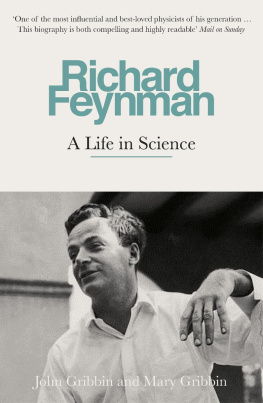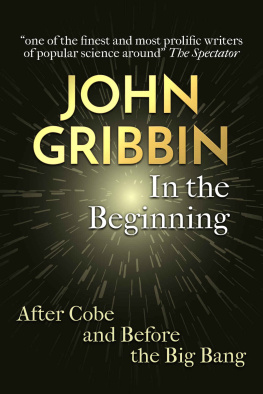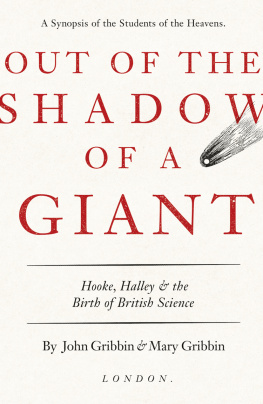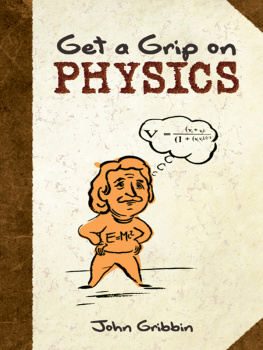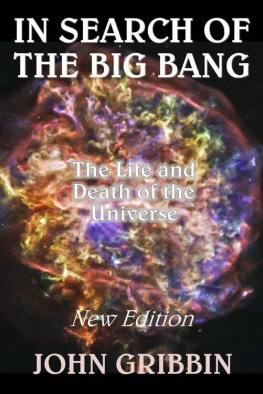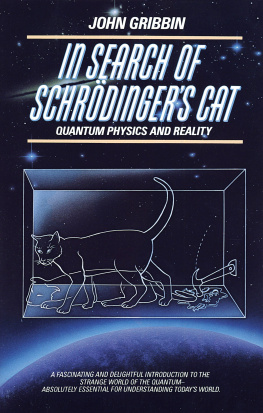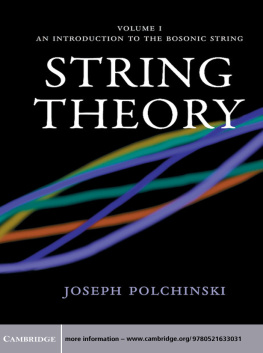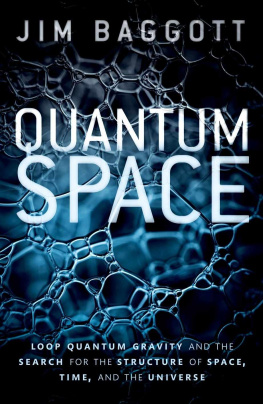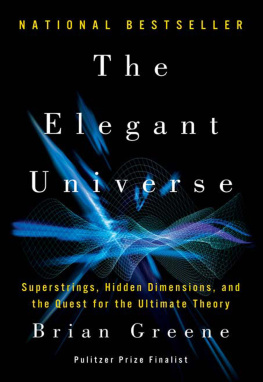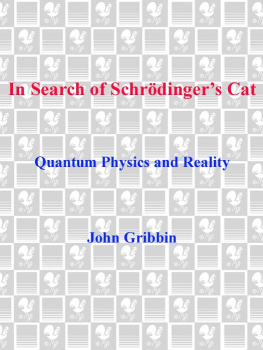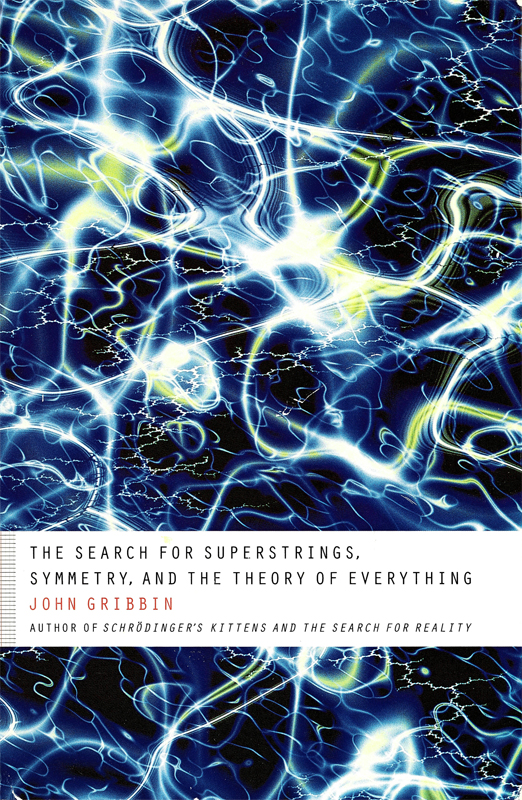Copyright 1998 by John and Mary Gribbin
Illustrations copyright 1998 by John Gribbin
All rights reserved. No part of this book may be reproduced in any form or by any electronic or mechanical means, including information storage and retrieval systems, without permission in writing from the publisher, except by a reviewer who may quote brief passages in a review.
First North American edition published by Little, Brown and Company, January 1999
First eBook Edition: November 2009
Portions of this book first appeared in In Search of the Big Bang.
Hachette Book Group
237 Park Avenue
New York, NY 10017
Visit our website at www.HachetteBookGroup.com
www.twitter.com/littlebrown
ISBN: 978-0-316-09292-0
Ever since Einstein came up with the General Theory of Relativity, the Holy Grail of physics has been a Theory of Everything that would explain the behavior of all the particles and forces in nature in one set of equations. Popular science writer Gribbin tackles this quest in a thorough yet palatable primer geared to the serious reader. Gribbin helps us get our bearings in a universe of eleven dimensions. Diligent readers without any specialized knowledge of physics or mathematics will come away with a flavor of the latest ideas theorists are grappling with. Overall, this is an exciting tour de force.
Publishers Weekly
Gribbin's enthusiasm is unmistakable, and his voice is friendly and reassuring as he guides us through this exotic material.
John Ashkenas, San Francisco Chronicle
A clear, comprehensive popular treatment of the cutting edge of physics.
Kirkus Reviews
From the author of In Search of Schrdinger's Cat and In Search of the Big Bang comes yet another enthusiastic exploration on and lucid explanation of scientific theory. Gribbin's straightforward approach leads the layman through the maze of scientific babble and ideas without either complicating or oversimplifying matters.
Katrina Dixon, The Scotsman (U.K.)
Writing in his clear prose style, Gribbin introduces the general reader to the mysterious world of high-energy physicsa formidable task because of the complex theories involved; nevertheless, he translates these ideas into a readable, enjoyable narrative. His extensive historical treatment of physics research from the foundation work done in the 19th century to the latest concepts of superstrings is remarkable. Gribbin takes the reader to a world of multidimensionsa fictionlike picturewhere scientists are trying to merge the forces of the universe in a grand unified theory called supersymmetry.
Nestor Osorio, Library Journal
One of England's best-known science writers Gribbin is an optimist, believing that we are ever closer to another Deep Truth about the universe. For those who want the story up to now, this is a fine place to begin.
David Williams, Seattle Times
A useful summary of the particle zoo. I think that people who have some knowledge of physics, and have encountered particle physics, will appreciate and enjoy this book.
Helen J. Walker, The Observatory (U.K.)
Unless one holds a physics doctorate and can tolerate 26 dimensions, the world of the supersmall seems unapproachably alien. Once again, the guide to the frontier is Gribbin, prolific popularizer of physics and physicists. Here he introduces the quarky zoo of subatomic particles and their mediating forces, Gribbin himself mediating for generalists the theories advanced to explain and unify them. In these mind-bending realms, Gribbin's seasoned skills wonderfully simplify matters (and forces) without dumbifying them.
Gilbert Taylor, Booklist
In Search of the Edge of Time
Hothouse Earth
Being Human
In Search of the Big Bang
In Search of Schrdinger's Cat
The Hole in the Sky
Stephen Hawking: A Life in Science
(WITH MICHAEL WHITE)
Albert Einstein: A Life in Science
The Matter Myth
(WITH PAUL DAVIES)
In the Beginning
Schrdinger's Kittens and the Search for Reality
Companion to the Cosmos
The Case of the Missing Neutrinos
Almost Everyone's Guide to Science
Thanks to Benjamin Gribbin
for editorial assistance
When I revised my book In Search of the Big Bang to bring it up to date and tell the entire story of the life and prospective death of the Universe, something had to go to make way for the new material. That something was mainly the detailed discussion of the world of sub-atomic particles, which was slightly tangential to the story of the Big Bang. No sooner had I done so, however, than various friends and colleagues that I discussed the project with bemoaned the loss, telling me that the kind of historical overview that the material had provided was all too rare in popular accounts of particle physics, or even in books aimed at students taking physics courses.
I took a second look, and felt that they might be right. So here, updated to the late-1990s, is the story of the particle world, from the discovery of the electron to the search for a supersymmetric theory explaining all of the forces and particles of nature in one mathematical package. It draws on materials from the original version of my Big Bang book, but does not overlap with the revised version of In Search of the Big Bang. The story isn't complete, because the mathematical physicists haven't yet found the ultimate theory of everything that they seek. But it will, I hope, shed some light on why they are looking where they are looking for the ultimate theory.
JOHN GRIBBIN

D uring the nineteenth century, chemists developed the idea, which dated back to the time of Democritus, in the fourth century BC, that everything in the material world is made up of tiny, indivisible particles called atoms. Atoms were thought of as being like tiny billiard balls, so small that it would take a hundred million of them, side by side, to stretch along a line I cm long. Atoms of a particular element each had the same mass, but the atoms of different elements, such as carbon, oxygen or iron, had different masses from one another, and the properties of the atoms, it was realized, determine the gross properties of larger quantities of the elements. When elements combine (for example, when carbon burns in air), it is because individual atoms of each element combine to make molecules (in this example, each atom of carbon combines with two atoms of oxygen to make carbon dioxide).
But just as the idea of atoms was becoming firmly established, in 1897 the English physicist J.J. Thomson, working at the Cavendish Laboratory in Cambridge, found a way to study bits that had been broken off atoms. The bits he broke off were much smaller and lighter than atoms, and carried negative electric charge; they were called electrons. They left behind atoms with a residual positive charge, now known as ions. Thomson's experiments in the 1890s showed that although atoms of different elements are different from each other, they all contain electrons, and that the electrons broken off from any atom are the same as the electrons broken off from any other atom.
While physicists were still coming to terms with the idea that bits could be chipped off from the indivisible atoms, the discovery of radioactivity was both giving them a new tool with which to probe the structure of atoms themselves and (although it was not realized at first) demonstrating that particles much larger than electrons could break off from atoms. At the beginning of the twentieth century, the New Zealander Ernest Rutherford, working at McGill University in Montreal with Frederick Soddy, showed that radioactivity involves the transformation of atoms of one element into atoms of another element. In the process, the atoms emit one or both of two types of radiation, named (by Rutherford) alpha and beta rays. Beta rays, it turned out, were simply fast-moving electrons. The alpha rays also turned out to be fast-moving particles, but much more massiveparticles each with a mass about four times that of an atom of hydrogen (the lightest element), and carrying two units of positive charge. They were, in fact, identical (apart from the speed with which they moved) to atoms of helium (the second lightest element) from which two electrons had been removedhelium ions. And their combination of relatively large mass (compared with an electron) and high speed gave Rutherford the tool he needed to probe the structure of atoms.


